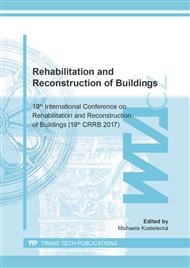p.66
p.70
p.76
p.81
p.86
p.92
p.98
p.104
p.121
Comparison of Ultrasonic Methods for Thermally Damaged Concrete Nondestructive Testing
Abstract:
Behaviour of concrete under elevated temperatures is very complex. There is a change of mechanical and physical parameters with temperature. In this paper we study the relations of thermal damage processes in concrete and parameters obtained by different ultrasonic methods. The concrete specimens were heated in programmable laboratory furnace. Selected temperature (200°C, 400°C, 600°C, 800°C, 1000°C and 1200°C) were maintained for 60 minutes. The first ultrasonic measurement technique in this paper was Ultrasonic Pulse Velocity method. The pulse velocity in a concrete depends on its density and its elastic properties. Therefore, it is possible to deduce the quality and the compressive strength of the concrete from the ultrasonic pulse velocity. The second ultrasonic measurement technique in this paper uses broadband pulse-compression signal, with variable amplitude to measure the change of fundamental frequency. This method is based on Nonlinear Elastic Wave Spectroscopy. Nonlinear Elastic Wave Spectroscopy methods takes advantage of the fact, that nonlinearities in material manifest themselves as a resonant frequency shifts and harmonics or dumping coefficients changes. The progress of nondestructive testing parameters was confirmed by results from the destructive tests.
Info:
Periodical:
Pages:
86-91
Citation:
Online since:
August 2018
Authors:
Price:
Сopyright:
© 2018 Trans Tech Publications Ltd. All Rights Reserved
Share:
Citation:


